
Road construction and maintenance projects across the world inevitably impact the environment.
The South African National Roads Agency (SOC) Limited (SANRAL) prides itself on its ability to strike a careful balance between the socio-economic benefits that a road or upgraded bridge will bring to a community and the need for sustainable environmental practices.
Management of the environment is at the core of decisions taken by SANRAL on every project – from conception and design to construction, delivery and ongoing maintenance.
Caring for the environment
The modern concept of caring for the environment goes way beyond looking after nature. It includes the long-term impact of the road on surrounding communities, the future of plant and animal species and issues relating to climate change.
Each SANRAL project is accompanied by a comprehensive environmental impact assessment. World-class experts from both SANRAL and independent companies assess the project, taking into account location, proximity to natural resources and the unique character of the region and communities who live close to the road.
One example is the N17 from Springs to Ermelo, which is of vital economic importance to Gauteng and Mpumalanga, as well as South Africa’s neighbours in Swaziland.
The planning of this road required the combined expertise of independent environmentalists, economists and experts in the fields of tourism, trade and commerce.
In the North West, the construction of a bridge on the N14 near Delareyville had implications for the Barberspan bird sanctuary – an internationally recognised conservation area that is home to more than 365 different bird species. During the construction, special care was taken not to disturb a rare colony of cliff swallows, while a range of other measures were introduced to mitigate the impact of the building activities on the sensitive ecosystem.
Then there’s the N2 Wild Coast Toll Highway. This project has attracted attention from both environmental activists and community organisations.
The original environmental assessment was referred back for more detailed studies, which resulted in a much-improved plan for the road. A survey conducted by the Human Sciences Research Council now shows that there is overwhelming public support for the project, which has the potential to unlock the tourism and agricultural potential of a region that has been neglected in the past.
During construction on the N2 between Grahamstown and the Fish River, SANRAL worked closely with a postgraduate student at Rhodes University to study a population of the Suurberg cushion bush (Oldenburgia grandis). This research resulted in the preservation of a very important plant species.
When planning started on the new Polokwane Eastern Ring Road in Limpopo, heritage experts expressed concerns about its potential impact on the rich archaeological history of the region.
When a few graves were discovered during construction, SANRAL halted its activities, brought in experts and worked with local communities to apply for the exhumation of the remains.
Climate change
Global concerns about climate change – and local concerns about power shortages – are important factors when the energy-efficiency of transport networks is considered. Again, SANRAL is taking the lead in innovation. On a section of the busy N2 in KwaZulu-Natal, a lighting management system was installed that enables an operator to control the overhead lighting and adjust it according to the time of day and traffic volume.
This system will lead to energy savings of up to 40% and has the potential to be rolled out to other sections of the national road network.
These examples all show that SANRAL takes its stewardship of the environment very seriously. The South African public can be assured that the agency is committed to sound environmental principles and that its decisions are based on the latest global research and practices.
This is an opinion piece by Mpati Mokoa, SANRAL’s Environmental Manager.

